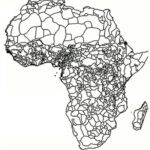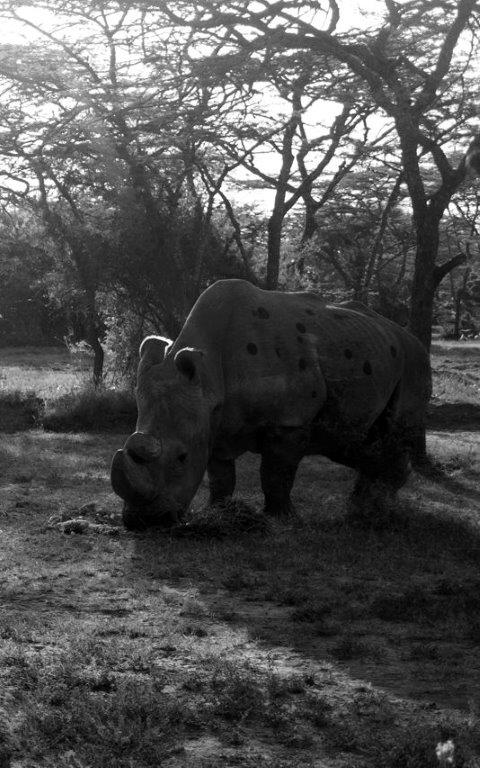Panting from the heat he lies in a pool of mud. Bubbles of air emerge from his derriere, caused by the fermented food in his stomach, and deep sighs escape from his large nostrils. Sudan is already 44 years old, a considerable age for a rhinoceros. “Just a little while and he will be dead,” Zacharias says sadly, one of his permanent guards. “Sudan is my father and brother, Sudan is my best friend”.
Sudan is the last of its kind, the only living male of the northern white rhinoceros. With difficulty he gets up, slips away, threatens to fall and stands up again. Sudan is The Last Male Standing. With pain and compassion, documentary filmmaker Floor van der Meulen follows his fight against extinction. “What is so attractive about extermination, that is the question I ask in the film The last male standing. Why do people from all over the world want to meet Sudan”, Van der Meulen wonders. “What does that say about us as people”.
Van der Meulen had previously made films about Syria, such as Paradise Stormers and Greetings from Aleppo*. Her new fascination is with a rhinoceros, which she has been following for two years now.
What do you have with that beast?
“I saw a picture in the newspaper with Sudan standing on the savannah with four armed ranchers around him, his own personal bodyguard team. Why should such a large and powerful and dangerous animal be protected by four armed men? That is the world upside down”.
Take the first road left after the equator in Kenya and you will arrive in Ol Pejeta, one of a series of private nature reserves under the watchful eye of Mount Kenya. Here Sudan lives in his own territory of 300 hectares. Born in what is now called South Sudan, he was captured at a young age and transferred to the Dvur Kralove zoo in Czechoslovakia. At that time, there were about 2000 northern white rhinos. In 2010 Sudan was flown back to Africa, hoping that the free nature of Ol Pejeta would incite him to procreate. At that time, no other one of his species was living in the wild anymore and only a few in zoos. In 2017 there were only three: Sudan and the two females Najin and Fatu, all three in Ol Pejeta.
Zacherias kisses Sudan behind the ear. He narrates how wonderful he finds it to be scribbled under his belly. “Sudan, good boy”, his guards lovingly talk to the huge gray armored animal. His veterinarian sees to it that in addition to what he grazes on the savannah, he also gets a special diet of hay and kilos of fresh carrots. A mini army watches over its security in a military manner, from watchtowers, with the aid of trained dogs and a helicopter.
In a surreal spectacle, Sudan’s sperm was taken under the watchful eye of the world press. Against expectations, the last male standing did not reproduce and so no viable embryo has been created. Moreover, the two females are too weak on their hind legs to endure a pregnancy. His sperm now flies around the globe and in Europe and America scientists, at the expense of millions of euros, are looking for a way to save his species. It is also being researched whether stem cell technology can help.
Meanwhile, the owners of Ol Pejeta made a circus of his imminent extinction. Charitable events raise funds and Sudan is prominent on the dating site Tinder. The bizarre show against the extinction has been further developed into a special tour along other endangered species in Ol Pejeta, such as gravy zebras, hartebeests and chimpanzees. Thousands of people and celebrities came on a pilgrimage, with Sudan as the main attraction. Until recently, visitors could touch him very briefly. It brought about a special psychological reaction. “I had spiritual contact with Sudan”, an excited teenager not yet fully recovered from the experience said. He promised after his return to England to commit himself to the protection of the species. Sudan evokes feelings as only the pampered pandas can. “Those fat lips,” said a female employee of Ol Pejeta amiable. “Sudan is more my lover than a friend”.
According to Van der Meulen, the fate of Sudan has brought the world together in Ol Pejeta. “There are people from all corners on the planet who come to touch him and they get tears in the eyes. They are moved and experience a deep love. I wonder whether someone puts his hands on his skin for the spiritual connection, or because it is exciting to touch the last of his kind”.
Is this all not a bit macabre? That humanity first destroys the habitat of Sudan and at the last moment make him into an icon to stop his extinction?
“As humanity, we are far too late”, says Van der Meulen. “Apparently, time after time mankind has to reach a dramatic low point. It seems a bit the tendency of man. We are able to do a lot of damage, but also bring about creation”.
You ask everyone in your documentary what Sudan told them. What did he tell you?
“What have you done to my kind, why can you not leave me alone? Why can I not exist alongside you on this planet. But also: leave me alone, because I am old “.
Fact file:
Around 1850 the eradication of the rhinoceros began by the introduction of modern weapons. European hunters started with it. There are only a few thousand left. There are five species of rhinoceros: those from India, Java and Sumatra and in Africa the black and the white, divided into the subspecies northern and southern rhinoceros. Around one hundred live in Ole Pejeta. But Sudan is the last of its kind.
This article was first published in NRC Handelsblad on 5-1-2018
All pictures taken by Christan Paulussen, except the one but last by Koert Lindijer
Photo’s of Sudan and Floor van der Meulen
* Storming Paradise (produced by Keydocs in collaboration with BNNVARA). And 9 Days – From My Window In Aleppo (in collaboration with director Thomas Vroege and Syrian photographer Issa Touma. Produced by Deep Focus Webdocs and Paradox)

